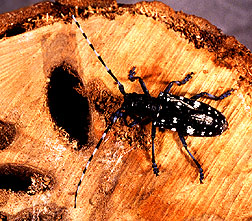Starry Sky Beetle—The Latest Amityville Horror
|
|
In China, it's called the starry sky beetle because of the white, celestial markings on its black body. But in the United States, this latest alien insect immigrant is commonly known as the Asian longhorn beetle, Anoplophora glabripennis.
"Whatever name you use," says Steven W. Lingafelter, "this pest and related species could have a devastating economic impact in the United States. It could cause millions of dollars in damage to ornamental trees and to the maple syrup and lumber industries." Lingafelter is a systematic entomologist with the Agricultural Research Service.
"This woodboring pest is native to China, Japan, and Korea and has a natural range broad enough to guarantee it can live in most sections of this country," he says.
The Asian longhorn beetle was first discovered on maple, horsechestnut, and elm trees in Brooklyn, New York, in October 1996. Last July, workers there began cutting down, chipping, and burning trees to slow the pest's spread. Since then, the beetle has moved on to other communities in New York, and other specimens have been seen across the country. In Amityville and Greenpoint, New York, the beetle is attacking many types of maple and horsechestnut trees.
Recently, adults and larvae have been intercepted in forest product shipments in California, South Carolina, and Canada. Early identification and cargo fumigation have so far prevented establishment of this species in these other areas.
That's where Lingafelter's work has been pivotal. He is an expert on the Asian longhorn beetle's family, Cerambycidae. It's his job to distinguish this new pest from hundreds of other related native woodboring beetles.
Since the larvae of the Asian longhorn beetle closely resemble many native species, regulatory agencies charged with containing the pest rely on the expertise of ARS' Systematic Entomology Laboratory (SEL) to identify any suspicious beetles. Correctly assigning names is a crucial first step to effective control methods.
Alien pests intercepted at U.S. ports of entry are routinely sent to the SEL, which has facilities at the Smithsonian Institution's Museum of Natural History in Washington, D.C., and at Beltsville, Maryland. There the agency's systematic entomologists maintain the world's largest collection of agricultural pests of quarantine significance.
Despite efforts to monitor U.S. borders for uninvited pests, some escape detection. Researchers believe this Asian longhorn, like many other woodboring beetles, entered the United States in wooden crates and braces used to transport cargo in ships. Since the larvae of these beetles live in and feed on the wood, they are easily overlooked.
"This family of woodboring beetles occurs worldwide," Lingafelter says. "The adults are characterized by an elongated body and very long antennae—usually at least as long as the body. They generally live as larvae for 1 to 3 years inside wood or roots before emerging as adults. They do their worst damage as larvae—the life stage when they bore holes in the wood of living trees.
"Of the thousands of native species of longhorned woodboring beetles in the United States, most cause little harm to living trees," says Lingafelter. "They consume dead wood, making them important primary decomposers in our forest ecosystems.
"However, some—like the cottonwood borer of the Great Plains, Plectrodera scalator, a close relative to Asian longhorn beetle—have caused millions of dollars in losses to U.S. trees," he says.
A USDA advisory committee that includes ARS and two sister agencies, the Forest Service and the Animal and Plant Health Inspection Service, is preparing a nationwide strategy to eradicate the new pest.
"Besides chipping and burning all affected trees, other possible controls—birds, parasitic wasps, other beetle larvae, and robber fly larvae—should also be studied," says Lingafelter. — By Hank Becker, Agricultural Research Service Information Staff, 6303 Ivy Lane, Greenbelt, Maryland 20770, phone (301) 344-2769.
Steven W. Lingafelter is at the USDA-ARS Systematic Entomology Laboratory, U.S. National Museum of Natural History, NHB 168, Washington, DC, 20560; phone (202) 382-1793, fax (202) 786-9422.
"Starry Sky Beetle—The Latest Amityville Horror" was published in the February 1998 issue of Agricultural Research magazine. Click here to see this issue's table of contents.







